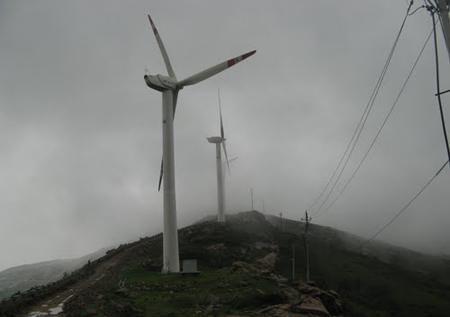(Ecns.cn) – Wind power is growing at a blinding pace in China, and has gained "gold-rush" status now that the country plans to develop clean-energy technologies at a faster speed and on a larger scale.
But the best spots for wind farms in the country's plains regions and offshore areas have already been snapped up, leading major power generation companies and wind power equipment suppliers to begin scouting in the mountain regions of southwest China's Guizhou Province in search of other breezy locations.
This has caused the Guizhou government to reevaluate its wind resources and modify its plan for wind power development. In 2007, the province claimed it had very limited wind resources, worth only 200,000 kilowatts of wind power, but the number was later changed to 4.27 million kilowatts after a more thorough investigation. Today, the province's wind deployment target has been adjusted to 9 million kilowatts by 2020, according to Nanfang Weekend.
In the past, everyone believed that Guizhou was not a good choice for wind farms due to its low wind speeds and complex geographical conditions. (The area ranks in the country's fourth category of wind resources, which means the average wind speed there is only two meters per second.) Even so, profit-seeking companies are more determined than ever to exploit the area.
Competition over resources
It was a normal day in November, and the remote southern part of Guizhou had already entered early winter, with fallen leaves on the ground. Along a road shrouded in mist, heavy trucks carrying 40-meter-long fan blades and large wind towers zigzagged carefully.
The trucks were probably headed to Guizhou's Weining County, in Bijie, where wind turbines are being erected daily on mountains that reach more than 2,500 meters above sea level.
Bijie is believed to be the best place for wind farms in Guizhou, and the area's wind power resources have already been divvied up between two power generation companies – China Longyuan Power Group Limited (Guizhou) under the China Guodian Corporation, and Huaneng Renewables Corporation Limited under the China Huaneng Group.
According to Nanfang Weekend, China Longyuan plans to build a 700,000 kilowatt wind project while Huaneng Renewables is set to build one capable of producing 800,000 kilowatts.
There are other wind power resources in Guizhou apart from Bijie, however. Equipment suppliers – even major ones like China Mingyang Wind Power Group, Baoding Tianwei Baobian Electric Co and Guangdong Dongxing Fengying Wind Power Equipment Co – are often forced to search in even more remote and less-developed areas.
Compared to state-owned enterprises, these private companies tend to combine wind farm construction with the acquisition of wind power resources, which means they agree to build wind farms under the condition that local governments give them control over the resulting generated power.
The governments are well aware that the construction of wind farms will not contribute much to local GDP growth, but the resulting wind turbine manufacturing process can drive growth and create jobs for local residents. Because of this, they must weigh the economic benefits seriously.
Promising investment?
Three years ago, China set its 2020 target for the country's wind power deployment at 30 gigawatts. Today, the number has already been lifted to 200 gigawatts.
The central government's policy of encouraging the development of alternative and renewable forms of energy has attracted massive investment in the wind power sector. Thanks to tax exemptions and reduction incentives, the current competition between power generation companies and wind power equipment suppliers is strong proof that the policy is working.
Though the State Council, China's cabinet, issued a No. 38 decree in 2009 to prohibit cutthroat competition over wind power resources, the overheating situation in Guizhou has become difficult to control.
Nevertheless, such encouraging policies do not necessarily guarantee profits, even as the cost of wind turbines continues to decrease.
According to Su Li, deputy manager of the Wind Power Department of Guizhou Changzheng Electric Co, the cost of wind turbines is about 75 percent of the total spending to build a wind farm, so the lower prices for turbines make the mountain wind resources exploitable.
Currently, the government subsidizes a wind farm with 0.61 yuan ($0.094) for each kilowatt-hour of electricity, but only if the annual electric energy production exceeds 2,000 hours. Judging from the ongoing wind projects in Guizhou, the situation is not on the optimistic side, however.
A staff member from Huaneng Renewables revealed that its cost of electricity generation is now 0.6878 yuan ($0.106) for each kilowatt-hour, but the subsidy is only 0.61 yuan, so production is already running at a loss.
The challenges to wind power resources in Guizhou are currently affordable for these companies, but they are expecting success in the future, not failure. Hopefully they can survive the market and eventually earn profits while also contributing to cutting greenhouse gas emissions in the country.


















